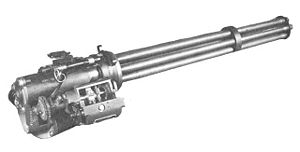- XM214 Microgun
-
XM214 Six-Pak 
XM214 MicrogunType Rotary barrel machine gun Place of origin  United States
United StatesService history In service US Army Production history Designer General Electric Designed 1970s Manufacturer General Electric/General Dynamics Produced 1970s - ?; In G.E. catalog until late 1990s[1] Number built Unknown; 10 Six-Paks delivered to WECOM/US Air Force Variants None known Specifications Weight basic gun 25.5 lb (Six-Pak 27 lb); drive motor 7.5 lb, side-stripping feeder 3 lb Length 41.0 inches (Six-Pak); basic gun 27.0 inches Cartridge 5.56x45mm M193 Caliber .223 Action Mechanically driven rotary breach; motor develops 0.75 hp @ 2,000 rpm; 1.5 hp @ 6,000 rpm; 3.2 hp @ 10,000 rpm Rate of fire Prototype and gun pod for aircraft: variable from 400 to 10,000 rpm (1,000; 6,000; 10,000 rpm were available) Six-Pak: variable from 400 to 4,000 rpm; bursts from 3 to 1,500 rounds
Muzzle velocity 3,250 ft/s, 990 m/s Feed system Belt and chute Sights Iron The XM214 was a prototype 5.56 mm rotary barreled machine gun. It was designed and built by General Electric, but it never reached mass production. Also known as the Microgun, the XM214 was a scaled-down version of the M134 "minigun", firing M193 5.56 x 45 mm ammunition.
Contents
History
The XM214 was first developed for aircraft applications. Later General Electric developed it into a man-portable weapon system, known as the GE Six-Pak. The complete Six-Pak system weighed 85 pounds (38.5 kg) with 1,000 rounds of ammunition, comparable in weight to some heavy machine guns. The basic gun in the Six-Pak weighed 27 pounds, or 12.2 kg. The system could be carried by a team of two soldiers and mounted either to an M122 tripod or a vehicle's pintle mount. Length overall is 104.1 cm, gun only is 68.6 cm long. Width (including ammunition case) is 44.4 cm. Sighting was usually by optical telescope.
The Six-Pak consisted of the XM214, the ammunition package, and the power module, and the ammunition module consisted of two 500 round, factory packed, and disposable cassettes mounted to a holding rack. Linked ammunition was fed through a flexible chute to the gun; when the first cassette was empty, ammunition would then feed from the second cassette, tripping a visible signal that a new cassette needed to be added to the rack. The power module contained a 24 volt nickel-cadmium battery, a 0.8 horsepower (0.60 kW) motor, and solid state electronic controls. Unless the battery was plugged into a vehicle's power supply, the battery's charge would be depleted after 3,000 rounds. The system could be broken down quickly into two portable loads of roughly 42 pounds apiece. This was accomplished by means of a quick-release fitting at that end of the belt chute fastened to the gun.
Electronic controls contained a burst limiter and handled the automatic clearing of the gun after bursts. Using the electronic controls, the weapon's rate of fire could be adjusted from 400 rpm all the way up to 4,000 rpm. Later editions of Jane's Infantry Weapons claimed a theoretical cyclic rate of up to 6,000 rpm. George Chinn, author of The Machine Gun Volume V, contended that the XM214 prototype had a rate of fire of up to 10,000 rpm, but the man-portable Six-Pak was limited to 4,000 rpm.
Microgun Pod
An 88 by 10 inch (224 x 25 cm) 5.56mm Microgun Pod was also developed for external use on light aircraft and helicopters. The unit had an ammunition capacity of from 1,500 to 3,500 rounds and loaded weight of 186 to 300 pounds. The feed system was linkless, via a helical drum, with a nominal rate of fire of 6,000 rpm. However, adjustments to 1,000 or 10,000 rpm were possible, if desired. Power could be provided by a built-in battery pack, or from the aircraft itself.
Possible resurrection
The rise of MOUT tactics in the early 2000s led to the resurrection of the XM214 system in a tank/APC CIWS role.[2] General Dynamics, who now hold the license for the Microgun, increased the ROF to 12,000 rpm and offered the weapon mounted on armored fighting vehicles as anti-RPG or anti-ATGM defense.[3]
See also
- Fokker-Leimberger
- Slostin machine gun
- Hua Qing Minigun
- M197 Gatling gun
- Minigun
- Gatling gun, the 1860s weapon that originated the rotating-barrel concept
References
- Chinn, George (1987). The Machine Gun Volume V. RAMP Inc.. ASIN B000GKSS1M.
Notes
- ^ http://world.guns.ru/machine/mg70-e.htm
- ^ http://www.angelfire.com/art/enchanter/XM214.html
- ^ http://www.gdatp.com/files/PDF/A085_XM214.pdf Access date: 21 November 2009.
External links
Multiple barrel firearms COP 357 · Garrucha · Howdah pistol · Lancaster pistol · Baylè 1879 · Bajōzutsu revolver · Henrion, Dassy & Heuschen Revolver · LeMat revolver · Double-barreled shotgun · M30 Luftwaffe drilling · TP-82 · Colt Defender Mark I · Winchester Liberator · Flash-ball · PB-4M · Heckler & Koch P11 · Mk1 UDG · SPP-1 underwater pistol · Krieghoff Model L · Nambu Type 90 · Redback · Nock · Double rifle · 80.002 · AO-63 · TKB-059 · TVGK · S&T Daewoo K11 · ITM Model 3 · Olin/Winchester FAL · Gordon CSWS · ITM Model 4 · Villar-Perosa aircraft submachine gun · Bira gun · Fokker-Leimberger · Gast gun · GShG-7.62 · Gardner gun · Gatling gun · Minigun · Mitrailleuse · Montigny mitrailleuse · Nordenfelt gun · Silin gun · Slostin machine gun ·Modern Gatling guns  German Empire7.92x57mmFokker-Leimberger
German Empire7.92x57mmFokker-Leimberger China7.62x54mmHua Qing Minigun
China7.62x54mmHua Qing Minigun Soviet Union ·
Soviet Union ·  RussiaGShG-5.45Slostin23x115mm AM-23
RussiaGShG-5.45Slostin23x115mm AM-23 United StatesXM214GAU-8/A · GAU-13/A37x219mmCategories:
United StatesXM214GAU-8/A · GAU-13/A37x219mmCategories:- 5.56 mm firearms
- Multi-barrel machine guns
- Aircraft guns
- Trial and research firearms
Wikimedia Foundation. 2010.
